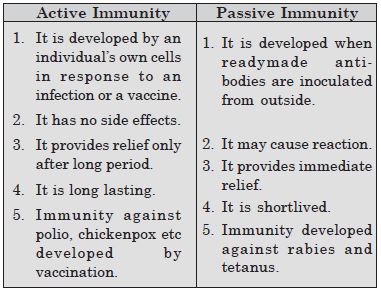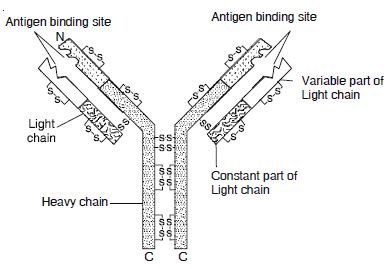Question 1:
What are the various public health measures, which you would suggest to safeguard us against infectious diseases?
Answer:
Public health measures. In order to prevent infectious diseases from contracting, the
following public health measures are to be followed:
1. Maintenance of public and personal hygiene like keeping the body clean ; consumption of
clean drinking water, food, vegetables, fruits etc.
2. Proper disposal of wastes and excreta, periodic cleaning and disinfection of water
reservoirs, pools, cesspools, tanks etc.
3. Avoidance of close contact with infected persons or their belongings.
4. For diseases like malaria and filariasis; stagnation of water in and around residential
areas, regular cleaning of household coolers, use of mosquito nets, spraying of insecticides
etc. should be done.
5. The most important measure is the successful implementation of immunisation programmes.
Question 2:
In which way the study of biology has helped us to control infectious diseases?
Answer:
The study of biology has made a tremendous impact over the control of infectious diseases in
the following ways:
1. A full fledged study called Immunology has allowed the development of ‘Vaccines’ which is
an anticipatory action to prevent disease outbreak. By this method, diseases like small pox,
diphtheria, pneumonia, tetanus have been controlled to a large extent and polio immunisation
programme is geared up rapidly.
2. Microbiology has enabled us to develop specific ‘antibiotics’ against diseases which
allow easy and quick treatment of diseases.
Question 3:
How transmission of each of the following diseases takes place:
(a) Amoebiasis
(b) Malaria
(c) Ascariasis
(d) Pneumonia?
Answer:
(a) Amoebiasis
Mode of transmission may be direct or oral. The tetranucleate cysts are ingested with food
and water.
(b) Malaria
Transmission of malaria is indirect. The sporozoites (infective stages) are introduced along
with the saliva of vector female anopheles mosquito.
(c) Ascariasis
Infection is direct and oral. Capsules containing embryonated eggs are ingested with
contaminated food and water.
(d) Pneumonia
Pneumonia is an airborne disease caused by Diplococcus pneumonia. Bacterial cysts are spread
by sputum of the patients.
Question 4:
What measures would you take to prevent water-borne diseases?
Answer:
Preventive measures against waterborne diseases
1. Consumption of clean drinking water.
2. Disinfection of water before drinking like boiling, chemical treatment or
chlorination.
3. Proper underground disposal of waste and excreta.
4. Periodic cleaning of water tanks, reservoirs, pools and cesspools.
5. Proper washing of fruits and vegetables before consumption.
Question 5:
Discuss with your teacher what does a ‘suitable gene’’ means, in the context of DNA vaccines.
Answer:
Suitable gene. Suitable gene means that a disease-resistant gene present on the genome of lower organism. If scientist can prepare vaccine by recombinant DNA technology (Genetic engineering) there is possibility a ‘suitable gene’ can be inserted in the body. It will direct the synthesis of vaccine and enable it to fight infection.
Question 6:
Name the primary and secondary lymphoid organs.
Answer:
Primary lymphoid organs
Bone Marrow.
Thymus.
Secondary lymphoid organs
Spleen
Lymph nodes
Tonsils
Peyer’s Patches of small intestine.
Question 7:
State the function of primary and secondary lymphoid organs.
Answer:
Primary lymphoid organs
Bone Marrow.
Thymus.
Secondary lymphoid organs
Spleen
Lymph nodes
Tonsils
Peyer’s Patches of small intestine.
Question 8:
The following are some well-known abbreviations, which have been used in this chapter. Expand
each one to its full form.
(a) MALT (b) CTL (c) NK cells
(d) NACO (e) HIV
Answer:
(a) MALT. Mucosa Associated Lymphoid Tissue.
(b) CTL. Cytotoxic-T-lymphocyte.
(c) NK cells. Natural Killer cells.
(d) NACO. National AIDS Control Organization.
(e) HIV. Human Immuno Deficiency Virus.
Question 9:
Differentiate between Innate and Acquired Immunity and give example.
Answer:
Differences between innate immunity and acquired immunity

Question 10:
Differentiate between Active and Passive Immunity and give example.
Answer:
Differences between active immunity and passive immunity

Question 11:
Draw a well labelled diagram of an antibody molecule.
Answer:
Structure of antibody (Fig. 8.1)

Question 12:
What are the various routes by which the transmission of human immunodeficiency virus takes place?
Answer:
The most common routes by which transmission of human immunodeficiency virus takes place are
:
1. Sexual intercourse.
2. Use of contaminated hypodermic needles and syringes.
3. Blood transfusion, organ transplantation.
4. Artificial insemination.
5. Infected mother to baby during parturition (30%) and breast feeding.
Question 13:
Trace the events that occur in human body to cause immunodeficiency when HIV gains entry into the body.
Answer:
Action of HIV in the body.
1. HIV enters into macrophages where RNA genome of the virus replicates to form viral DNA
with the help of the enzyme reverse transcriptase (Discovered by Temin).
2. This viral DNA gets incorporated into host cell’s DNA and directs the infected cells to
produce virus particles.
3. The macrophages continue to produce virus and in this way acts like a HIV factory.
4. HIV enters into helper (TH) T-lymphocytes (a type or subset of T-lymphocytes
of the immune system), replicates and produce progeny viruses.
5. The progeny viruses released in blood attack other helper T-lymphocytes. This is repeated
leading to a progressive decrease in the number of helper Tlymphocytes in the body of the
infected person.
6. During this period, the person suffers from bouts of fever, diarrhoea and weight
loss.

7. Due to decrease in the number of helper Tlymphocytes, the person starts suffering from
infection due to bacteria such as Mycobacterium, viruses, fungi and even parasite
Toxoplasma.
8. The patient becomes so much immunologically deficient and unable to fight against such
infections.
Question 14:
How is a cancerous cell (neoplastic cell) different from a normal cell?
Answer:
Differences between cancerous cell and normal cell

Question 15:
Explain what is meant by metastasis.
Answer:
Metastasis. Small pieces of primary tumour
break off and are carried to other body parts by the blood or lymph where these form the
secondary tumours. This process is called metastasis. So metastasis is the process of
transference of cancerous cells from the site of origin to distant parts of the body.
The most frequent sites of metastasis are lymph nodes, lungs, long bones, liver, skin and
brain. Metastasis is the most feared property of malignant tumours.
Question 16:
Enlist the various harmful effects which alcohol/drug abuse may have on adolescents.
Answer:
Harmful Effects of Alcohol. It has been proved that the intake of alcohol
affects individual health, family life and ultimately creates several community and social
problems.
I. Effects on Individual Health
1. Effect of Nervous System. (i) Alcohol depresses the nervous system, thus acting as a
sedative, analgesic and anaesthetic agent. It reduces the efficiency of every tissue of the
body.
(ii) In a chronic alcoholic the axons of the nerve are inflammed, thus causing neuritis.
(iii) The prolonged effect of alcohol on the nervous system causes various mental and
physical symptoms.
2. Effect on Heart. Alcohol is high risk factor for coronary heart diseases (CHD). It
dilates the blood vessels. Due to constant dilation, the arterial walls soon become brittle
and rigid. Such a change in the property
of blood vessels and deposition of alcoholic fat affect the working of the heart.
3. Effect on Stomach. Alcohol affects the lining of the stomach and causes inflammation and
become the victims of gastritis and peptic ulcers.
4. Effect on Liver. The liver is the storehouse of glycogen but alcohol causes the storage
of fat in the liver. It causes fatty liver syndrome. Gradually, the liver hardens and dries
up as its cells are replaced by a fibrous tissue. This kind of liver degeneration is called
cirrhosis. Once the liver is damaged, it affects the other organs of the body also.
5. Effect on Kidneys. Kidneys are overworked in eliminating the excess water often taken
with alcohol and leads to kidney failure.
6. Effect on immunity. The users of alcohol neglect their health and soon the body loses its
resistance to infections. The alcoholics are in most cases victims of malnutrition and are
easily susceptible to
disease like pneumonia.
II. Effect on the Family. Alcoholic drinks are costly and most drinkers,
because of their selfish habit, deprive their children and other members of the
family of the basic needs.
III. Effect on Society (Community). (i) The drinking of alcohol is invariably
associated with social crimes and dissolution of moral and cultural inhibitions.
(ii) Violence and other corrupt practices in the community are often directly or
indirectly due to the consumption of alcohol.
(iii) The intake of alcohol increases the rate of industrial accidents and decreases
production.
(iv) Traffic accidents are often due to drunken drivers. Illegal activities like
production and selling of illicit liquor increases antisocial activities.
Harmful effects of drugs
1. Opiates act as depressant and the excess consumption of opiates may cause
death due to blockage of respiration.
2. Stimulants like amphetamines impair vision and judgement of distance.
3. Overdose of cocaine may cause death due to cardiovascular or respiratory
failure.
4. LSD is most dangerous hallucinogen which is known to cause chromosomal
and foetal abnormalities.
Question 17:
Do you think that friends can influence one to take alcohol/drugs? If yes, how may one protect himself/herself from such an influence?
Answer:
Yes, undue peer pressure and a race to be trendy
may influence one to take alcohol/drugs. One may protect
himself/herself from such an influence by adopting the
following methods :
(1) practising good habits.
(2) attaining good quality education.
(3) obtaining counselling as and when required.
(4) seeking help from parents.
(5) attaining proper guidance from teachers.
(6) maintaining good company.
(7) seeking expert professional and medical help if
required.
Question 18:
Why is that once a person starts taking alcohol or drugs, it is difficult to get rid of this habit? Discuss it with your teacher.
Answer:
It is true that once a person gets entangled in the deadly whirlpool of alcohol or drugs, it
is very difficult to get rid of this habit because in the absence of a continuous supply of
alcohol/drugs, the person starts showing certain symptoms called withdrawal signs which are
listed below:
(1) anxiety (2) shakiness
(3) nausea (4) sweating.
Question 19:
In your views, what motivates the youngsters to take alcohol or drugs and how can this be avoided?
Answer:
(a) Main motivating factors which stimulate the youngsters to take to alcohol or drug
are:
1. Peer pressure
2. Desire for excitement
3. Liking of taste
4. To escape from frustrations
5. Family’s history
6. Curiosity due to advertisements
7. False belief of enhanced performance
8. To overcome the hardships and miseries of daily life.
(b) Alcohol or drug abuse can be avoided by:
(1) practising good habits.
(2) attaining good quality education.
(3) obtaining counselling as and when required.
(4) seeking help from parents.
(5) attaining proper guidance from teachers.
(6) maintaining good company.
(7) seeking expert professional and medical help if required.
